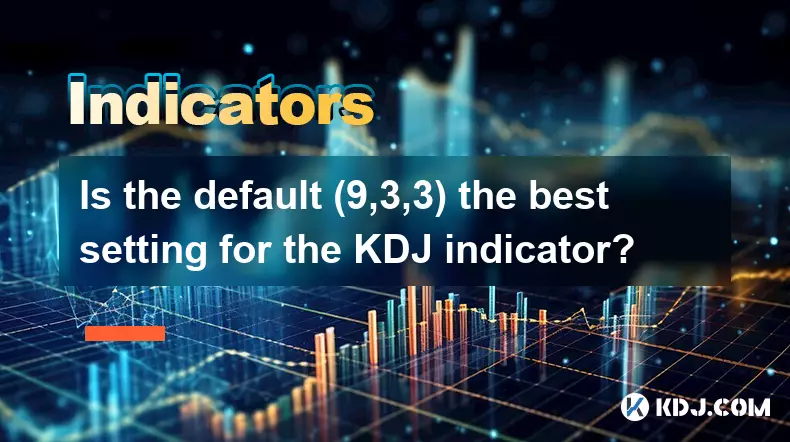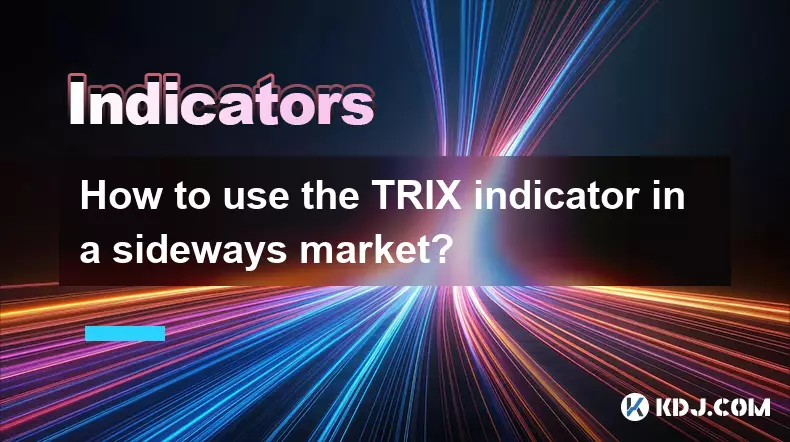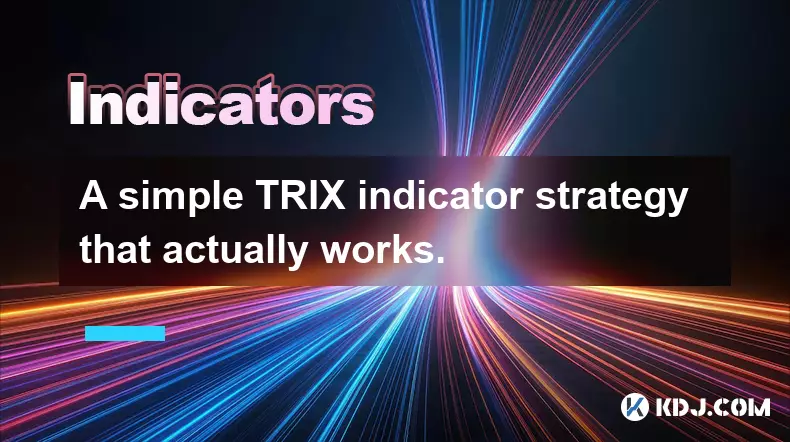-
 bitcoin
bitcoin $105968.894684 USD
4.17% -
 ethereum
ethereum $3639.320047 USD
7.62% -
 tether
tether $1.000339 USD
0.06% -
 xrp
xrp $2.407774 USD
5.96% -
 bnb
bnb $1011.704193 USD
2.28% -
 solana
solana $166.942754 USD
6.37% -
 usd-coin
usd-coin $1.000143 USD
0.03% -
 tron
tron $0.291515 USD
0.25% -
 dogecoin
dogecoin $0.181682 USD
4.06% -
 cardano
cardano $0.585450 USD
4.54% -
 hyperliquid
hyperliquid $42.099968 USD
5.20% -
 chainlink
chainlink $16.160745 USD
5.45% -
 zcash
zcash $645.269648 USD
12.96% -
 bitcoin-cash
bitcoin-cash $507.430338 USD
2.80% -
 stellar
stellar $0.290357 USD
3.69%
Is the default (9,3,3) the best setting for the KDJ indicator?
The KDJ indicator, with its (9,3,3) default, helps crypto traders spot overbought/oversold levels, but optimal settings vary by market volatility, timeframe, and asset type.
Nov 11, 2025 at 12:20 am

Understanding the KDJ Indicator in Cryptocurrency Trading
The KDJ indicator, an extension of the stochastic oscillator, is widely used in cryptocurrency trading to identify overbought and oversold conditions. It consists of three lines: %K (fast), %D (slow), and %J (divergence). The default setting of (9,3,3) refers to a 9-period lookback for %K, a 3-period moving average for %D, and another 3-period smoothing for %J. This configuration has become standard due to its balance between responsiveness and reliability across various markets.
1. The (9,3,3) setting was originally designed for daily charts in traditional financial markets, where 9 days represented a typical short-term cycle. In the fast-moving crypto market, this may still offer a reasonable baseline, especially for traders focusing on medium-term trends.
- Many traders stick with the default because it filters out excessive noise while still capturing meaningful price momentum shifts. On volatile assets like Bitcoin or Ethereum, sudden spikes can generate false signals, and the triple-smoothed nature of the KDJ helps reduce such occurrences.
- However, the assumption that (9,3,3) is universally optimal lacks empirical backing in the context of digital assets. Crypto markets operate 24/7, exhibit higher volatility, and are influenced by different drivers than traditional equities, which may require adjusted parameters.
- Some quantitative analysts have tested alternative configurations such as (14,3,3) or (5,3,3) on historical BTC/USDT data and found that performance varies significantly depending on the time frame and market regime—ranging from bull runs to consolidation phases.
- Backtesting results show that during high-volatility periods, shorter settings like (5,2,2) can provide earlier entry signals, though at the cost of increased whipsaws. Conversely, longer settings like (14,3,3) tend to lag but confirm stronger trend reversals.
Evaluating Performance Across Timeframes
Different chart intervals demand distinct approaches when applying the KDJ indicator. The effectiveness of any parameter set depends heavily on the trader’s strategy and the asset’s behavior over specific durations.
1. On 1-hour charts, the (9,3,3) setup often produces timely signals for swing traders, aligning well with intraday momentum shifts without being overly sensitive.
- For 15-minute or lower timeframes, faster configurations such as (6,2,2) are frequently preferred to keep pace with rapid price movements common in altcoin pairs.
- Weekly charts benefit from extended lookbacks; some traders use (18,3,3) or even (21,3,3) to capture macro-level turning points in long-term cycles.
- Cross-asset analysis reveals that stablecoins rarely generate actionable KDJ signals due to minimal price variation, whereas highly speculative memecoins often trigger repeated overbought/oversold readings under any setting.
- Machine learning models trained on multi-year crypto data suggest that adaptive KDJ parameters—adjusted dynamically based on volatility clusters—outperform fixed settings across most major exchanges.
Customization Based on Market Conditions
Rigid adherence to default values overlooks the adaptive nature required in cryptocurrency trading. Market phases such as accumulation, breakout, parabolic rise, and capitulation each call for tailored technical setups.
1. During sideways markets, tightening the %K period to 7 or 8 enhances sensitivity to minor breakouts, helping traders anticipate range expansions before they occur.
- In trending environments, extending the %K window to 11 or 12 reduces premature reversal signals, allowing positions to remain aligned with dominant momentum.
- High-frequency trading bots often employ non-standard KDJ inputs like (4,2,3) or (7,3,2), optimized through reinforcement learning algorithms fed on order book dynamics.
- Integration with volume-weighted variants improves accuracy, particularly when combined with on-chain metrics such as exchange outflows or whale movement thresholds.
- Traders using KDJ in conjunction with RSI or MACD report better risk-adjusted returns when parameters are calibrated to match the correlation structure between indicators, rather than relying on defaults.
Frequently Asked Questions
What does the J line indicate in the KDJ indicator?The J line represents the divergence between the %K and %D lines, calculated as 3×%K – 2×%D. When J exceeds 100, the market is considered overbought; below 0 suggests oversold conditions. Extreme J values often precede sharp reversals, especially in leveraged crypto derivatives markets.
Can the KDJ indicator be applied to futures trading?Yes, the KDJ is commonly used in perpetual and futures contracts on platforms like Binance and Bybit. Traders monitor divergences between price and the KDJ to spot potential liquidation cascades, particularly when funding rates are elevated and the J line hits extreme levels.
How do you avoid false signals when using KDJ in crypto?Filtering KDJ crossovers with confirmation from candlestick patterns, support/resistance levels, or on-chain activity reduces false entries. For example, an oversold KDJ reading near a known demand zone backed by rising exchange net outflows increases signal validity.
Is there a way to automate KDJ-based strategies?Algorithmic systems can execute trades based on KDJ thresholds using APIs from exchanges. Scripts can be programmed to open long positions when %K crosses above %D below 20, close them when %K crosses down through %D above 80, and integrate stop-loss logic tied to recent volatility bands.
Disclaimer:info@kdj.com
The information provided is not trading advice. kdj.com does not assume any responsibility for any investments made based on the information provided in this article. Cryptocurrencies are highly volatile and it is highly recommended that you invest with caution after thorough research!
If you believe that the content used on this website infringes your copyright, please contact us immediately (info@kdj.com) and we will delete it promptly.
- Lightning Network: Bitcoin Reality Check or Scaling Mirage?
- 2025-11-11 04:40:01
- XRP Analyst's Bold Stance: Why Holders Might Be Closer to a Rebound Than They Think
- 2025-11-11 02:50:02
- Monad, Token Sales, and Coinbase: A New Era for Crypto?
- 2025-11-11 03:35:01
- Milk Mocha's $HUGS: Presale Frenzy & NFT Rewards – A Crypto Love Story
- 2025-11-11 03:22:11
- Coinbase, Monad, and the Future of Token Sales: A New Era?
- 2025-11-11 03:00:01
- America, Changes, and the Penniless: Are Pennies Really Worth It?
- 2025-11-11 03:22:11
Related knowledge

What's the best way to learn the TRIX indicator?
Nov 10,2025 at 12:39pm
Understanding the Basics of the TRIX Indicator1. The TRIX (Triple Exponential Average) indicator is a momentum oscillator designed to filter out short...

How do professional traders use the TRIX indicator?
Nov 06,2025 at 04:40pm
Understanding the TRIX Indicator in Crypto TradingThe TRIX (Triple Exponential Average) indicator is a momentum oscillator used by professional trader...

Can I use the TRIX indicator on my mobile trading app?
Nov 07,2025 at 07:40pm
The TRIX indicator, a momentum oscillator designed to filter out short-term fluctuations and highlight long-term trends, has become increasingly popul...

How to use the TRIX indicator in a sideways market?
Nov 10,2025 at 03:00pm
Bitcoin’s Role in Decentralized Finance Evolution1. Bitcoin remains the cornerstone of decentralized finance, serving as both a store of value and a b...

How to code a simple TRIX indicator script in Pine Script?
Nov 07,2025 at 06:20am
How to Code a Simple TRIX Indicator in Pine Script The TRIX (Triple Exponential Moving Average) indicator is widely used in cryptocurrency trading to ...

A simple TRIX indicator strategy that actually works.
Nov 08,2025 at 05:39pm
Understanding the TRIX Indicator in Crypto Trading1. The TRIX (Triple Exponential Average) indicator is a momentum oscillator designed to filter out s...

What's the best way to learn the TRIX indicator?
Nov 10,2025 at 12:39pm
Understanding the Basics of the TRIX Indicator1. The TRIX (Triple Exponential Average) indicator is a momentum oscillator designed to filter out short...

How do professional traders use the TRIX indicator?
Nov 06,2025 at 04:40pm
Understanding the TRIX Indicator in Crypto TradingThe TRIX (Triple Exponential Average) indicator is a momentum oscillator used by professional trader...

Can I use the TRIX indicator on my mobile trading app?
Nov 07,2025 at 07:40pm
The TRIX indicator, a momentum oscillator designed to filter out short-term fluctuations and highlight long-term trends, has become increasingly popul...

How to use the TRIX indicator in a sideways market?
Nov 10,2025 at 03:00pm
Bitcoin’s Role in Decentralized Finance Evolution1. Bitcoin remains the cornerstone of decentralized finance, serving as both a store of value and a b...

How to code a simple TRIX indicator script in Pine Script?
Nov 07,2025 at 06:20am
How to Code a Simple TRIX Indicator in Pine Script The TRIX (Triple Exponential Moving Average) indicator is widely used in cryptocurrency trading to ...

A simple TRIX indicator strategy that actually works.
Nov 08,2025 at 05:39pm
Understanding the TRIX Indicator in Crypto Trading1. The TRIX (Triple Exponential Average) indicator is a momentum oscillator designed to filter out s...
See all articles























![🔥 Long awaited! The ancestor of Pi coin is about to take off? PI friends, come in and take a look! [Daily Coin Selection | Bitcoin Trend | Money Making Opportunities] 🔥 Long awaited! The ancestor of Pi coin is about to take off? PI friends, come in and take a look! [Daily Coin Selection | Bitcoin Trend | Money Making Opportunities]](/uploads/2025/11/10/cryptocurrencies-news/videos/6911e42f9bad7_image_500_375.webp)


















































